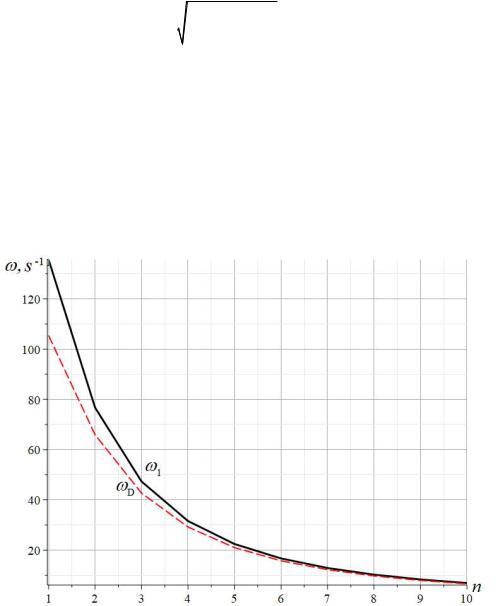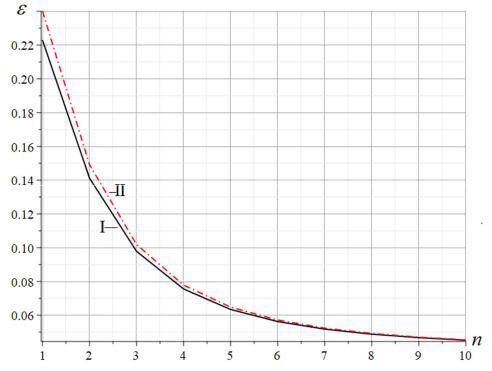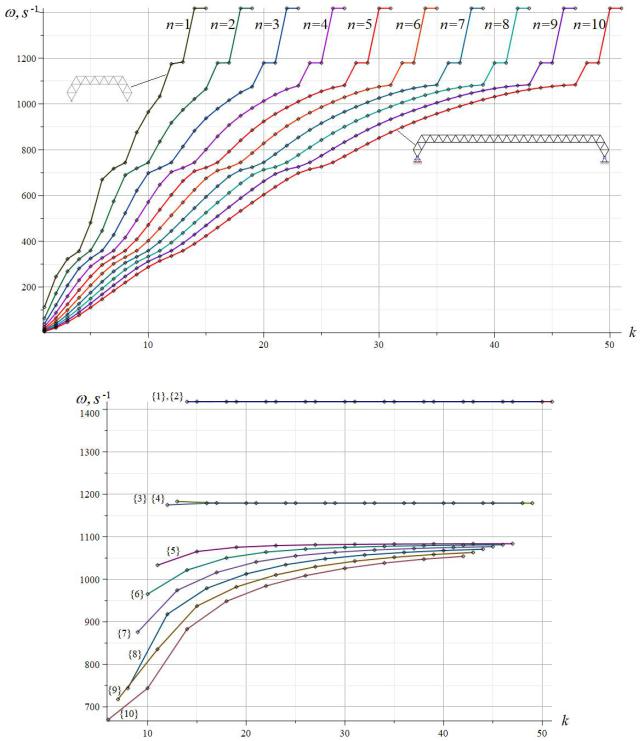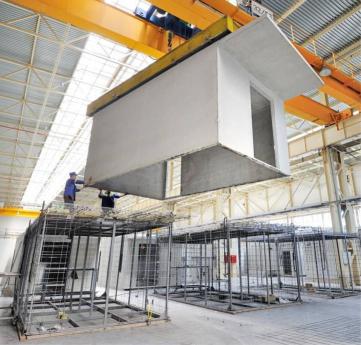
Строительная механика и сопротивление материалов. Прикладные задачи механики деформируемого твердого тела. Сафронов В.С., Козлов В
.pdf
2
identity Y Y, where is — the natural frequency of oscillations, we obtain the equation
2mBNY Y 0.
The problem was reduced to the problem of the eigenvalues 1/(m 2 ) of the matrix BN . In the general case, such a problem can only be solved numerically. The approximate solution according to the Dunkerley method [22] for the lower estimate of the first vibration frequency D is expressed in terms of the vibration frequencies of individual loads in the marked nodes:
2 |
N |
|
|
2 |
, |
(3) |
|
D |
k |
k 1
where k is the partial frequency of oscillations of the mass m located at the truss node. When calculating the partial frequency, equation (1) takes the form of a scalar form: myk dk yk 0, where dk is the stiffness coefficient, yk is the mass displacement, and yk is the acceleration. Hence, the oscillation frequency of one load (partial frequency) has the form: k 
 dk /m . The stiffness
dk /m . The stiffness
|
|
|
|
coefficient is calculated using the Mohr integral: k |
1/ dk |
S(k) 2 |
l / (EF) . It is denoted |
|
|
1 |
|
here: S(k) — forces in the rod with the number from the action of a single vertical force applied to the node where the mass with the number is located. From (3) follows:
|
|
|
|
|
|
N |
|
|
|
|
|
|
|
|
D2 |
m k m n. |
(4) |
||||||||||||
|
|
|
|
|
|
k 1 |
|
|
|
|
|
|
|
|
Sequentially calculating the coefficient n , we obtain |
|
|||||||||||||
|
|
25(4a f ) |
, |
|
|
|
|
|
|
|
||||
|
|
|
|
|
|
|
|
|
|
|||||
1 |
|
|
|
|
|
2EF |
|
|
|
|
|
|
|
|
|
|
|
|
|
|
|
|
|
|
|
|
|
||
2 |
|
1638a 181f |
, |
|
|
|
|
|||||||
|
|
|||||||||||||
|
|
|
|
|
|
12EF |
|
|
|
|
|
|
|
|
3 |
|
10709a 567 f |
, |
|
|
(5) |
||||||||
|
|
|||||||||||||
|
|
|
|
|
|
32EF |
|
|
|
|
|
|
|
|
4 |
|
217240a 6111f |
, |
|
||||||||||
|
|
|
||||||||||||
|
|
|
|
|
|
300EF |
|
|
|
|
|
|
||
5 |
|
151993a 2487 f |
,... |
|
||||||||||
|
|
|||||||||||||
|
|
|
|
|
|
108EF |
|
|
|
|
|
|
||
General view of the solution for the coefficient n: |
|
|||||||||||||
|
|
|
n |
(C a C |
2 |
f )/ (EF(n 1)2 ) |
(6) |
|||||||
|
|
|
|
1 |
|
|
|
|
|
|
|
|||
We find the coefficients in this formula by generalizing the corresponding coefficients in
(5). Direct application of the Maple operators does not work in this case. In order to find the common members of the sequences of coefficients for a and f, it was necessary to choose the form of their denominators depending on n. As a result, we have
C1 (512n6 3072n5 9680n4 21600n3 34133n2 29103n 9900)/5490,
(7)
C2 (32n3 180n2 265n 123)/12.
61

From here, taking into account (3) and (4), we obtain the final formula for the lower limit of the first natural oscillation frequency of the truss:
D (n 1) |
EF |
(8) |
|
|
. |
||
|
|||
|
m(C1a C2 f ) |
|
|
To estimate the approximate analytical solution (8) with coefficients (7), we compare (8) with the first frequency of the entire frequency spectrum obtained from the numerical solution of the problem of oscillation of a system with N degrees of freedom. To find the eigenvalues of a matrix BN , you can use the Maple Eigenvalues operator. The graph (Fig. 4) compares the
dependence curves of the first frequency 1 obtained numerically and D by formula (8). The curves are very close, and after n 5 they practically coincide. It is assumed: EF 0.5 106 kН, m = 400 kg, a = 2 m, f = 1 m. The relative error 1 D / 1 decreases with an increase in the
number of panels (Fig. 5). For more rigid supports (supports modeled by rods of shorter length f), the error is slightly larger.
Fig. 4. Frequency dependence on the number of panels
The resulting formulas can be used to estimate the fundamental frequency of truss oscillations with a very large number of rods. The accuracy of the numerical calculation with an increase in the number of panels naturally (due to the accumulation of rounding errors) decreases, while the accuracy of the obtained analytical solution increases.
62

Fig. 5. Dunkerley estimation error depending on the number of panels.
I — f = 1m; II — f = 0.25 m
The solution error, depending on the number of panels, varies from 4% to 24% for a truss with one panel in half a crossbar or 14% with two panels.
The upper estimate of the lowest frequency by the Rayleigh method is also known [18, 19]. The Rayleigh method gives even greater accuracy, but the analytical solution is too cumbersome.
Isolines of natural frequency spectra
To assess the accuracy of the analytical solution according to Dunkerley, all frequencies of the spectra of trusses of various orders were calculated. During the analysis of the spectra, a feature of the frequency distribution over the spectra was noticed (Fig. 6). The spectra of trusses with the number of panels n from 1 to 10 in half of the crossbar are constructed for the same truss parameters as the graphs in Figure 4. The points of the spectrum (frequency) of each truss are conditionally connected by broken lines. There is some order in the frequency distribution pattern. First, the higher frequencies of each spectrum are almost the same and form four distinct groups.
The first group of two higher frequencies is located around the frequency 1420s 1 , the second —
around the frequency 1190s 1. Second, each truss (except n = 1) has the same number of multiple frequencies. Spectral isolines can be distinguished in the spectra (Fig. 7). The isoline with the number {1} consists of the highest (last in the spectrum, ordered in ascending order) truss frequencies of various orders. The isolines with the number {2} connect the penultimate frequencies in the spectrum. In the general case, the isoline {v} of the set of regular trusses of orders consists of frequencies N 1 v , where N 4n 11 is the number of degrees of freedom of
the truss of order n or the number of the last frequency in the spectrum.
63

Fig. 6. Frequency spectra of regular trusses
Fig. 7. Isolines of the spectra of regular trusses of various orders
Isolines {5} - {10} asymptotically tend to some constant frequency. Isolines {1}-{4}, starting from some number, are spectral constants. The spectra of spatial regular trusses were studied in [23].
Conclusion
The considered truss has one very important property. All rods in it have the same length. In fact, this is a two parametric system. One parameter is the length of the rod, the other is the number of panels n in half the length of the crossbar. Despite this, the obtained analytical solutions are not
64
much simpler than solutions for systems with three or more parameters. A similar composite truss without taking into account the compliance of supports and with an arbitrary number not only in the crossbar, but also in the side parts, was studied in [14, p. 84]
Analytical estimates of deflection and vibration frequencies for practical engineers do not require additional computer calculations and can serve as an approximate solution for designed structures and for checking the accuracy of numerical solutions. A distinctive feature of the Dunkerley frequency estimate in this work is its high accuracy. In spatial systems [23], such an accuracy cannot be obtained. As a rule, the accuracy of the lower estimate of the first frequency of natural oscillations of spatial systems [23] is about 50%, which forces us to use the upper Rayleigh estimate in such problems, which has a more cumbersome form.
This work was financially supported by the Russian Science Foundation 22-21-00473.
References
1.Cao L., Liu J., Chen Y.F. Vibration performance of arch prestressed concrete truss girder under impulse excitation. Engineering Structures. 2018. 165. Pp. 386–395. DOI:10.1016/j.engstruct.2018.03.050.
2.Zhang X., Li Q., Wang Y., Wang Q. Vibration of a U-shaped steel – concrete composite hollow waffle floor under human-induced excitations. Advances in Structural Engineering. 2020. 23(14). Pp. 2996–3008. DOI:10.1177/1369433220927278. 3.
3.Li J., Zhang R., Liu J., Cao L., Chen Y.F. Determination of the natural frequencies of a prestressed cable RC truss floor system. Measurement: Journal of the International
Measurement |
Confederation. |
2018. |
122. |
Pp. |
582–590. |
DOI:10.1016/j.measurement.2017.08.048. |
|
|
|
|
|
4.Goloskokov D.P., Matrosov A. V. A Superposition Method in the Analysis of an Isotropic Rectangle. Applied Mathematical Sciences. 2016. 10(54). DOI:10.12988/ams.2016.67211. URL: www.m-hikari.comhttp://dx.doi.org/10.12988/ams.2016.67211 (date of application: 17.06.2020).
5.Goloskokov D.P., Matrosov A. V. Comparison of two analytical approaches to the analysis of grillages. 2015 International Conference on “Stability and Control Processes” in Memory of V.I. Zubov, SCP 2015 - Proceedings. 2015. Pp. 382–385. DOI:10.1109/SCP.2015.7342169.
6.Hutchinson R.G., Fleck N.A. Microarchitectured cellular solids - The hunt for statically determinate periodic trusses. ZAMM Zeitschrift fur Angewandte Mathematik und Mechanik. 2005. 85(9). Pp. 607–617. DOI:10.1002/zamm.200410208.
7.Hutchinson R.G., Fleck N.A. The structural performance of the periodic truss. Journal of the Mechanics and Physics of Solids. 2006. 54(4). Pp. 756–782. DOI:10.1016/j.jmps.2005.10.008.
8.Rakhmatulina A.R., Smirnova A.A. The dependence of the deflection of the arched truss loaded on the upper belt, on the number of panels. Science Almanac. 2017. 28(2–3). Pp. 268–271. DOI:10.17117/na.2017.02.03.268. URL: http://ucom.ru/doc/na.2017.02.03.268.pdf (date of application: 9.05.2021).
9.Kitaev S.S. Derivation of the formula for the deflection of a cantilevered truss with a rectangular diagonal grid in the computer mathematics system Maple. Postulat. 2018. 5–1. Pp. 43. URL: http://e-postulat.ru/index.php/Postulat/article/view/1477 (date of application: 3.03.2021).
10.Ilyushin A. The formula for calculating the deflection of a compound externally statically indeterminate frame. Structural mechanics and structures. 2019. 3(22). Pp. 29–38. URL: https://www.elibrary.ru/download/elibrary_41201106_54181191.pdf.
65
11.Arutyunyan V.B. Calculation of the deflection of a statically indeterminate beam truss. Postulat. 2018. 6(6). URL: http://vuz.exponenta.ru/1/ar18.pdf.
12.Dai Qiao; Analytical Dependence of Planar Truss Deformations on the Number of Panels; 2021; AlfaBuild; 17 Article No 1701. DOI: 10.34910/ALF.17.1
13.Kirsanov M.N., Zaborskaya N. Deformations of the periodic truss with diagonal lattice. Magazine of Civil Engineering. 2017. 71(3). DOI:10.18720/MCE.71.7.
14.Kirsanov M. N. Trussed Frames and Arches: Schemes and Formulas. Cambridge Scholars Publishing, 2020. 178 p.
15.Low K.H. A modified Dunkerley formula for eigenfrequencies of beams carrying concentrated masses. International Journal of Mechanical Sciences. 2000. 42(7). Pp. 1287– 1305. DOI:10.1016/S0020-7403(99)00049-1.
16.Trainor P.G.S., Shah A.H., Popplewell, N. Estimating the fundamental natural frequency of towers by Dunkerley’s method. Journal of Sound and Vibration. 1986. 109(2). Pp. 285–292. DOI:10.1016/S0022-460X(86)80009-8.
17.Levy C. An iterative technique based on the Dunkerley method for determining the natural frequencies of vibrating systems. Journal of Sound and Vibration. 1991. 150(1). Pp. 111– 118. DOI:10.1016/0022-460X(91)90405-9.
18.Mochida Y., Ilanko S. On the Rayleigh-Ritz Method, Gorman’s Superposition Method and the exact Dynamic Stiffness Method for vibration and stability analysis of continuous systems. Thin-Walled Structures. 2021. 161. Pp. 107470. DOI:10.1016/j.tws.2021.107470.
19.Low K.H. Natural frequencies of a beam-mass system in transverse vibration: Rayleigh estimation versus eigenanalysis solutions. International Journal of Mechanical Sciences. 2003. 45(6–7). Pp. 981–993. DOI:10.1016/j.ijmecsci.2003.09.009.
20.Petrenko V. The natural frequency of a two-span truss; 2021; AlfaBuild; 20 Article No 2001. DOI: 10.34910/ALF.20.1
21.Buka-Vaivade K., Kirsanov M.N., Serdjuks D.O. Calculation of deformations of a cantilever-frame planar truss model with an arbitrary number of panels. Vestnik MGSU. 2020. (4). Pp. 510–517. DOI:10.22227/1997-0935.2020.4.510-517
22.Vorobev O. Bilateral analytical estimation of first frequency of a plane truss // Construction of Unique Buildings and Structures. 2020. Vol. 92. Article No 9204 DOI: 10.18720/CUBS.92.4
23.Kirsanov M., Vorobyev O. Calculating of a spatial cantilever truss natural vibration frequency with an arbitrary number of panels: analytical solution; 2021; Construction of Unique Buildings and Structures; 94 Article No 9402. DOI: 10.4123/CUBS.94.2
Библиографический список
1.Cao L., Liu J., Chen Y.F. Vibration performance of arch prestressed concrete truss girder under impulse excitation. Engineering Structures. 2018. 165. Pp. 386–395. DOI:10.1016/j.engstruct.2018.03.050.
2.Zhang X., Li Q., Wang Y., Wang Q. Vibration of a U-shaped steel – concrete composite hollow waffle floor under human-induced excitations. Advances in Structural Engineering. 2020. 23(14). Pp. 2996–3008. DOI:10.1177/1369433220927278. 3.
3.Li J., Zhang R., Liu J., Cao L., Chen Y.F. Determination of the natural frequencies of a prestressed cable RC truss floor system. Measurement: Journal of the International
Measurement |
Confederation. |
2018. |
122. |
Pp. |
582–590. |
DOI:10.1016/j.measurement.2017.08.048. |
|
|
|
|
|
4.Goloskokov D.P., Matrosov A. V. A Superposition Method in the Analysis of an Isotropic Rectangle. Applied Mathematical Sciences. 2016. 10(54). DOI:10.12988/ams.2016.67211. URL: www.m-hikari.comhttp://dx.doi.org/10.12988/ams.2016.67211 (date of application: 17.06.2020).
66
5.Goloskokov D.P., Matrosov A. V. Comparison of two analytical approaches to the analysis of grillages. 2015 International Conference on “Stability and Control Processes” in Memory of V.I. Zubov, SCP 2015 - Proceedings. 2015. Pp. 382–385. DOI:10.1109/SCP.2015.7342169.
6.Hutchinson R.G., Fleck N.A. Microarchitectured cellular solids - The hunt for statically determinate periodic trusses. ZAMM Zeitschrift fur Angewandte Mathematik und Mechanik. 2005. 85(9). Pp. 607–617. DOI:10.1002/zamm.200410208.
7.Hutchinson R.G., Fleck N.A. The structural performance of the periodic truss. Journal of the Mechanics and Physics of Solids. 2006. 54(4). Pp. 756–782. DOI:10.1016/j.jmps.2005.10.008.
8.Rakhmatulina A.R., Smirnova A.A. The dependence of the deflection of the arched truss loaded on the upper belt, on the number of panels. Science Almanac. 2017. 28(2–3). Pp. 268–271. DOI:10.17117/na.2017.02.03.268. URL: http://ucom.ru/doc/na.2017.02.03.268.pdf (date of application: 9.05.2021).
9.Kitaev S.S. Derivation of the formula for the deflection of a cantilevered truss with a rectangular diagonal grid in the computer mathematics system Maple. Postulat. 2018. 5–1. Pp. 43. URL: http://e-postulat.ru/index.php/Postulat/article/view/1477 (date of application: 3.03.2021).
10.Ilyushin A. The formula for calculating the deflection of a compound externally statically indeterminate frame. Structural mechanics and structures. 2019. 3(22). Pp. 29–38. URL: https://www.elibrary.ru/download/elibrary_41201106_54181191.pdf.
11.Arutyunyan V.B. Calculation of the deflection of a statically indeterminate beam truss. Postulat. 2018. 6(6). URL: http://vuz.exponenta.ru/1/ar18.pdf.
12.Dai Qiao; Analytical Dependence of Planar Truss Deformations on the Number of Panels; 2021; AlfaBuild; 17 Article No 1701. DOI: 10.34910/ALF.17.1
13.Kirsanov M.N., Zaborskaya N. Deformations of the periodic truss with diagonal lattice. Magazine of Civil Engineering. 2017. 71(3). DOI:10.18720/MCE.71.7.
14.Kirsanov M. N. Trussed Frames and Arches: Schemes and Formulas. Cambridge Scholars Publishing, 2020. 178 p.
15.Low K.H. A modified Dunkerley formula for eigenfrequencies of beams carrying concentrated masses. International Journal of Mechanical Sciences. 2000. 42(7). Pp. 1287– 1305. DOI:10.1016/S0020-7403(99)00049-1.
16.Trainor P.G.S., Shah A.H., Popplewell, N. Estimating the fundamental natural frequency of towers by Dunkerley’s method. Journal of Sound and Vibration. 1986. 109(2). Pp. 285–292. DOI:10.1016/S0022-460X(86)80009-8.
17.Levy C. An iterative technique based on the Dunkerley method for determining the natural frequencies of vibrating systems. Journal of Sound and Vibration. 1991. 150(1). Pp. 111– 118. DOI:10.1016/0022-460X(91)90405-9.
18.Mochida Y., Ilanko S. On the Rayleigh-Ritz Method, Gorman’s Superposition Method and the exact Dynamic Stiffness Method for vibration and stability analysis of continuous systems. Thin-Walled Structures. 2021. 161. Pp. 107470. DOI:10.1016/j.tws.2021.107470.
19.Low K.H. Natural frequencies of a beam-mass system in transverse vibration: Rayleigh estimation versus eigenanalysis solutions. International Journal of Mechanical Sciences. 2003. 45(6–7). Pp. 981–993. DOI:10.1016/j.ijmecsci.2003.09.009.
20.Petrenko V. The natural frequency of a two-span truss; 2021; AlfaBuild; 20 Article No 2001. DOI: 10.34910/ALF.20.1
21.Buka-Vaivade K., Kirsanov M.N., Serdjuks D.O. Calculation of deformations of a cantilever-frame planar truss model with an arbitrary number of panels. Vestnik MGSU. 2020. (4). Pp. 510–517. DOI:10.22227/1997-0935.2020.4.510-517
67

22.Vorobev O. Bilateral analytical estimation of first frequency of a plane truss // Construction of Unique Buildings and Structures. 2020. Vol. 92. Article No 9204 DOI: 10.18720/CUBS.92.4
23.Kirsanov M., Vorobyev O. Calculating of a spatial cantilever truss natural vibration frequency with an arbitrary number of panels: analytical solution; 2021; Construction of Unique Buildings and Structures; 94 Article No 9402. DOI: 10.4123/CUBS.94.2
ДЕФОРМАЦИИ И СПЕКТР СОБСТВЕННЫХ ЧАСТОТ ПЛОСКОЙ РЕГУЛЯРНОЙ ФЕРМЫ С ТРЕУГОЛЬНОЙ РЕШЕТКОЙ
М. Н. Кирсанов
Национальный исследовательский университет «МЭИ» Россия, г. Москва
Д-р физ.-мат. наук, профессор кафедры робототехники, мехатроники, динамики и прочности машин,
тел.: +7(495)362-73-14; e-mail: c216@ya.ru
Формула зависимости прогиба статически определимой фермы рамного типа от числа панелей выводится методом индукции в системе компьютерной математики Maple. Рассмотрена равномерная и сосредоточенная нагрузка на верхний пояс. Приведена картина распределения усилий по стержням фермы. Методом Донкерлея найдена аналитическая оценка снизу первой частоты колебаний в предположении, что масса фермы равномерно распределена по узлам. Обобщение решения на произвольное число панелей производится методом индукции. Решение сравнивается с численным решением для всего спектра частот, найденного при помощи оператора решения задачи о собственных числах Eigenvalues системы Maple. Отмечается высокая точность полученной оценки, растущая с увеличением числа панелей. В множестве спектров регулярных ферм различного порядка обнаружены спектральные изолинии и спектральные константы. Погрешность аналитической оценки, представляющей формулу с коэффициентами в виде полиномов по числу панелей не выше шестого порядка, не превышает 24%. При числе панелей больше восьми погрешность оценки меньше 5%.
Ключевые слова: ферма, рама, метод Донкерлея, колебания, основная частота, индукция, Мaple, изолинии, спектральные константы
68

РАСЧЕТ И ПРОЕКТИРОВАНИЕ ЖЕЛЕЗОБЕТОННЫХ КОНСТРУКЦИЙ
DOI 10.36622/VSTU.2022.32.1.006 УДК 624.046.5: 69.059.2: 699.88
АНАЛИЗ РАСЧЕТНЫХ МОДЕЛЕЙ ПЛАТФОРМЕННЫХ СТЫКОВ ПРИ ПРОЕКТИРОВАНИИ КОНСТРУКЦИЙ ОБЪЕМНО-БЛОЧНЫХ ЗДАНИЙ
А. С. Саражинский1, С. В. Ефрюшин2
Воронежский государственный технический университет1,2 Россия, г. Воронеж
1Аспирант кафедры строительной механики, тел.: +7(904) 211-40-22, e-mail: sarazhinskijandrew@gmail.com
2Канд. техн. наук, доцент кафедры строительной механики, тел.: +7(910)341-52-66, e-mail: ooo.stroynauka@mail.ru
Анализ литературы, посвященной расчетным моделям объемно-блочных конструктивных систем, показывает, что по сравнению с работами по расчету панельных зданий, исследований по объемно-блочным зданиям недостаточно, поэтому работы в этом направлении имеют свою актуальность. Для того чтобы проектировать и выполнять прочностные расчеты объемно-блочных конструктивных систем, исследовать различные варианты объемно-планировочных и конструктивных решений, нужно иметь хорошо обоснованную расчетную математическую модель. Расчетную модель объемно-блочных конструктивных систем необходимо начать рассматривать с модели платформенного стыка, через который объемные блоки опираются друг на друга по высоте здания.
В работе приводятся практические выводы и рекомендации по выбору расчетной модели платформенного стыка объемно-блочных конструктивных систем. Опыт проделанных расчётов может быть использован при проектировании объемно-блочных зданий.
Ключевые слова: объемно-блочное домостроение, варианты расчетной модели платформенного стыка объемно-блочных конструктивных систем, ПК «Лира-САПР».
Объемно-блочное домостроение – быстрый и экономичный способ возведения зданий. Монолитные здания обладают преимуществами свободной планировки и повышенной этажности, но имеют высокую стоимость и трудоемкость строительства. Потребность в бюджетном жилье, возводимом в короткие сроки, привела к определению крупнопанельного домостроения в массовый сегмент строительной отрасли. В объемноблочном домостроении так же, как и в панельном домостроении процессы изготовления строительных конструкций осуществляются в заводских условиях, далее на строительной площадке происходит их монтаж. Конструктивная схема объемно-блочных зданий состоит из отдельных объемных блоков, которые устанавливают, рядом и друг на друга. При этом каждый блок представляет собой законченный конструктивный элемент, обладающий определенной прочностью для восприятия нагрузки от лежащих выше блоков. Пространственная жесткость объемно-блочных зданий обеспечивается совместной работой системы столбов объемных блоков, образующих перекрестную систему стен и горизонтальных плит перекрытий. Объединение в общую пространственную систему производится стальными сварными связями на закладных деталях, устанавливаемых в плоскости перекрытий, а также путем замоноличивания горизонтальных и вертикальных
© Саражинский А. С., Ефрюшин С. В., 2022
69

швов между блоками. Объемные блоки устанавливаются друг на друга через растворный шов. Для того чтобы проектировать и выполнять прочностные расчеты объемно-блочных конструктивных систем, исследовать различные варианты объемно-планировочных и конструктивных решений, нужно иметь хорошо обоснованную расчетную математическую модель. Расчетную модель объемно-блочных конструктивных систем необходимо начать рассматривать с модели горизонтального стыка, через который объемные блоки опираются друг на друга по высоте здания.
Существует три типа объемных блоков: тип «колпак», тип «стакан», тип «лежащий стакан». Для анализа расчетных моделей платформенных стыков рассмотрим объемные блоки типа «колпак» производства ООО «Выбор-ОБД – призматическую оболочку, имеющую пять граней (четыре стены и потолок). Размеры объемных блоков в плане – 6000х3550 мм, высота – 2760 мм, стены толщиной 100 мм, плита перекрытия толщиной 160 мм. Класс бетона по прочности на сжатие не ниже В20. Объемный блок типа «колпак» производства ООО «Выбор-ОБД» показан на рис. 1.
Рис. 1. Конструкция объемного блока «Выбор-ОБД»
Анализ литературы посвященной расчетным моделям объемно-блочных конструктивных систем, показывает, что по сравнению с работами по расчету панельных зданий, исследований по объемно-блочным зданиям недостаточно, поэтому работы в этом направлении имеют свою актуальность. При разработке расчетной модели платформенного стыка объемно-блочных конструктивных систем за основу приняты рекомендации пособия по проектированию жилых зданий [1]. В пособие [1] вошли рекомендации по проектированию панельных зданий из нормативных документов, а также методики, основанные на результатах проведённых экспериментов. Историю развития подходов к расчету крупнопанельных зданий можно проследить из нормативных документов [2], [3], [4]. Практика применения рекомендаций для расчета крупнопанельных зданий приведены в статьях [5], [6]. За основу данной работы были приняты устоявшиеся инженерные практики расчета крупнопанельных зданий.
Анализ трудов по расчету крупнопанельных зданий определил различные варианты расчетной модели платформенного стыка объемно-блочных конструктивных систем:
70
